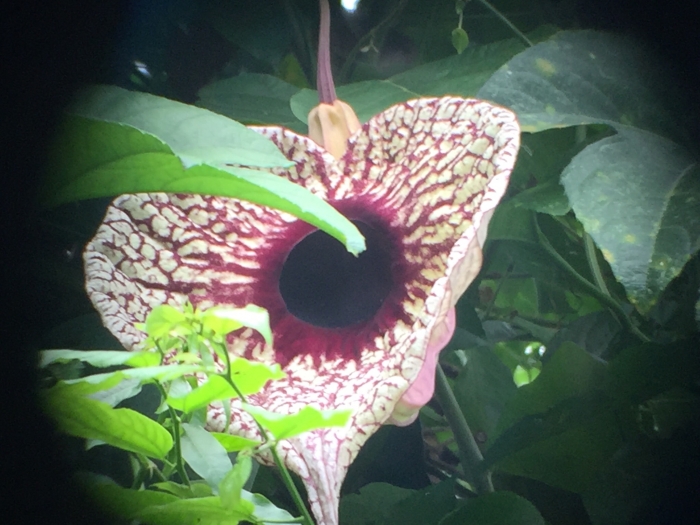Pelican Flower
(Aristolochia grandiflora)
Pelican Flower (Aristolochia grandiflora)
/
/

Peter Desmet
Public Domain
Image By:
Peter Desmet
Recorded By:
Copyright:
Public Domain
Copyright Notice:
Photo by: Peter Desmet | License Type: Public Domain | License URL: http://creativecommons.org/publicdomain/zero/1.0/ | Rights Holder: Peter Desmet | Publisher: iNaturalist | Date Created: 2016-12-14T14:06:37Z |































Estimated Native Range
Summary
Aristolochia grandiflora, commonly known as Pelican Flower, is a deciduous perennial vine native to the understory of tropical rainforests in Central and South America and the Caribbean. It can climb to heights of 20-30 feet with a similar spread, using surrounding vegetation for support. The plant is renowned for its large, ornate flowers that can reach up to 18 inches in width, displaying a complex structure with mottled green, white, purple, and red colors. These flowers bloom in the summer and fall and are designed to attract pollinating insects with their unique shape and sometimes unpleasant scent.
Pelican Flower is valued for its dramatic, unusual flowers which make it a conversation piece in any garden. It is used in tropical and subtropical gardens as a feature plant on trellises or arbors. In cultivation, it requires a warm, humid environment with dappled shade, moist but well-drained soil, and regular watering. While it can be a stunning addition to the right garden, Aristolochia grandiflora has a vigorous growth habit and can become invasive if not managed properly. It is also known to contain aristolochic acid, which is toxic and carcinogenic, so care should be taken in its handling and placement.CC BY-SA 4.0
Pelican Flower is valued for its dramatic, unusual flowers which make it a conversation piece in any garden. It is used in tropical and subtropical gardens as a feature plant on trellises or arbors. In cultivation, it requires a warm, humid environment with dappled shade, moist but well-drained soil, and regular watering. While it can be a stunning addition to the right garden, Aristolochia grandiflora has a vigorous growth habit and can become invasive if not managed properly. It is also known to contain aristolochic acid, which is toxic and carcinogenic, so care should be taken in its handling and placement.CC BY-SA 4.0
Plant Description
- Plant Type: Vine
- Height: 20-30 feet
- Width: 20-30 feet
- Growth Rate: Moderate
- Flower Color: Green, White, Purple, Red
- Flowering Season: Summer, Fall
- Leaf Retention: Deciduous
Growth Requirements
- Sun: Full Sun, Part Shade
- Water: Medium
- Drainage: Medium
Common Uses
Bird Garden, Butterfly Garden, Fragrant, Hummingbird Garden, Low Maintenance, Potted Plant, Showy Flowers
Natural Habitat
native to the understory of tropical rainforests in Central and South America and the Caribbean
Other Names
Common Names: Duckflower, Pelican-Flower, Großblütige Pfeifenwinde, Pelikanpipranka, Duck-Flower
Scientific Names: , Aristolochia grandiflora, Aristolochia gorgona, Aristolochia gigantea, Aristolochia pichinchensis, Aristolochia gigas, Aristolochia grandiflora var. hookeri, Aristolochia foetens, Aristolochia gigas subsp. sturtevantii, Aristolochia gigas var. sturtevantii
GBIF Accepted Name: Aristolochia grandiflora Sw.